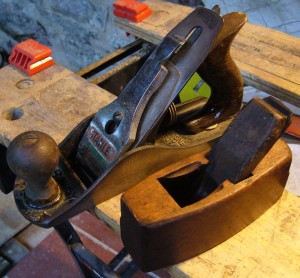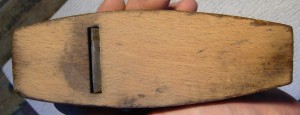Lately I’ve been adding to my collection of hand planes (I’m intending to mostly use traditional hand tools to produce the wooden parts of my concertinas). I picked up a cute little antique wooden coffin plane for a few quid in a junk shop this weekend. It’s a bevel-down smoother but it’s small and light enough to comfortably use in one hand. Here it is next to my Stanley no. 4 for comparison:
I lapped the sole flat using fine sandpaper on a sheet of glass. In this photo from half-way through the process you can see how they tend to wear most in the area in front of the mouth because of the way the wood you are planing is constantly being lifted by the splitting action of the blade. If this area of the sole is too concave you get excessive tear-out in the workpiece.
The back of the blade was very rough, probably hand forged by a local blacksmith from a piece of scrap tool steel. It seems nicely tempered though – it took a fine edge and didn’t show any damage after hitting a few hard knots with it.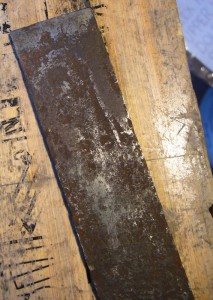
It took me a couple of hours of tedious hand lapping on a coarse oilstone followed by running up through the grits to a fine polish to get the back to a decent condition. I ended up giving it a slight amount (a degree or two) of back-bevel to get rid of the deep pitting near the edge without removing metal from the entire length of the blade.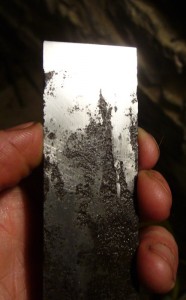
After sharpening and polishing the bevel and a coat of beeswax on the wood, it sizzled nicely through a piece of scrap pine, shooting nice curly shavings out of the mouth.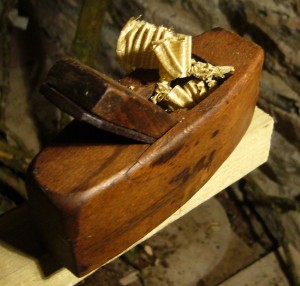 If it has a flaw, it’s that it has a fairly thin blade and no cap iron, so the blade has a bit more flex than I’m used to, which means it doesn’t do very well on end grain and it has a tendency to dig in and stall when you hit a knot.
If it has a flaw, it’s that it has a fairly thin blade and no cap iron, so the blade has a bit more flex than I’m used to, which means it doesn’t do very well on end grain and it has a tendency to dig in and stall when you hit a knot.
